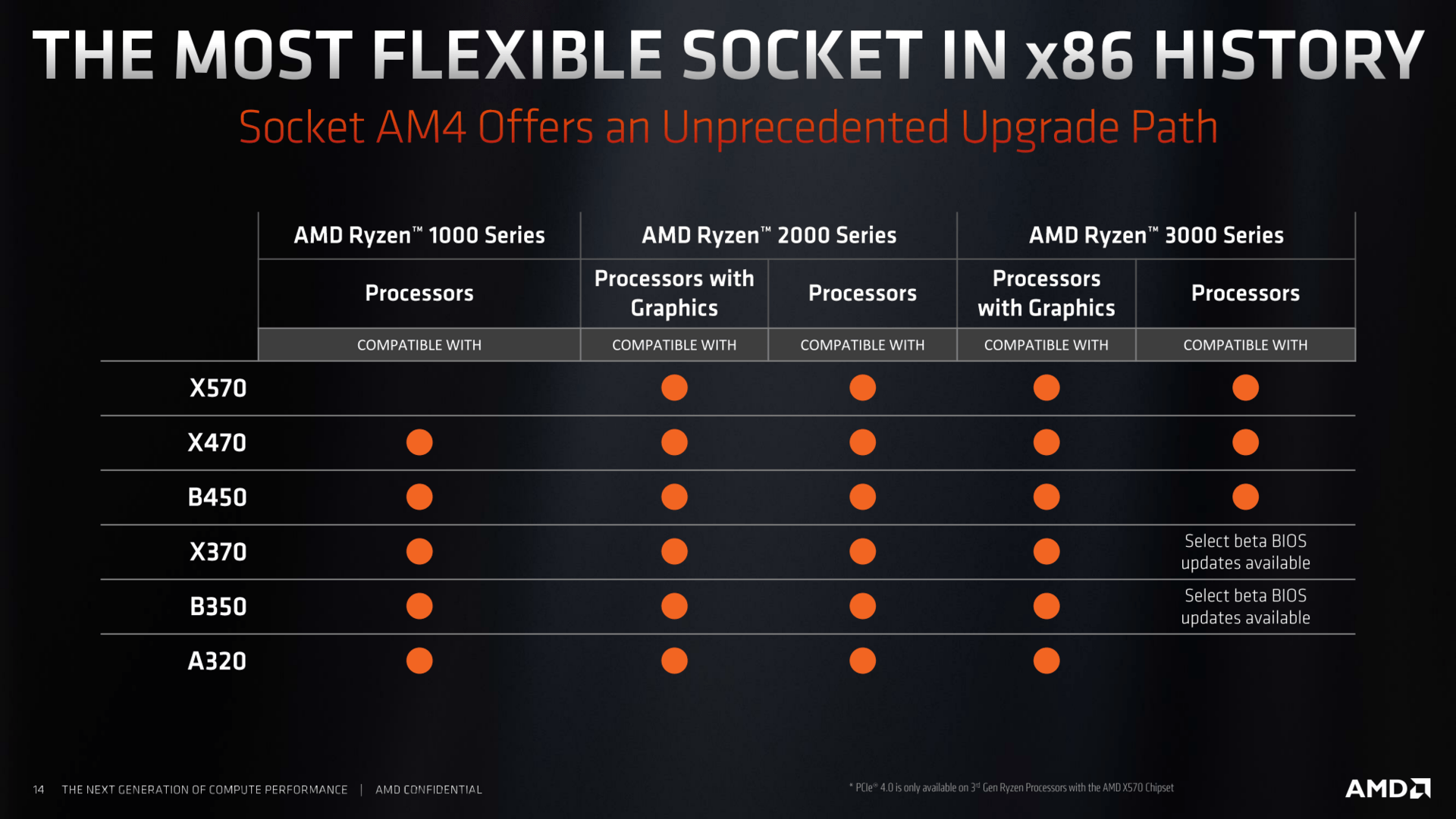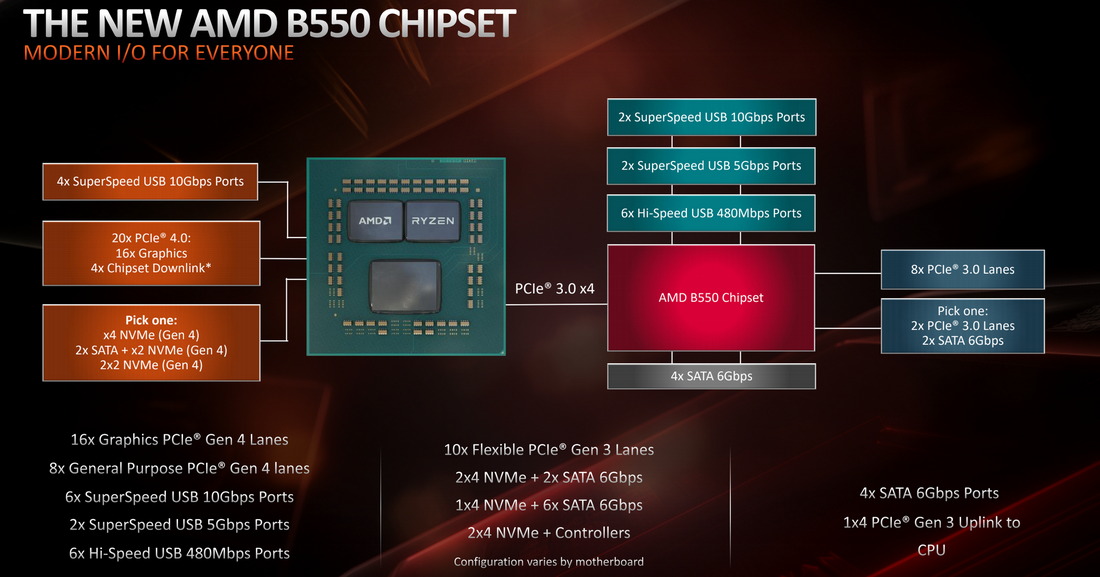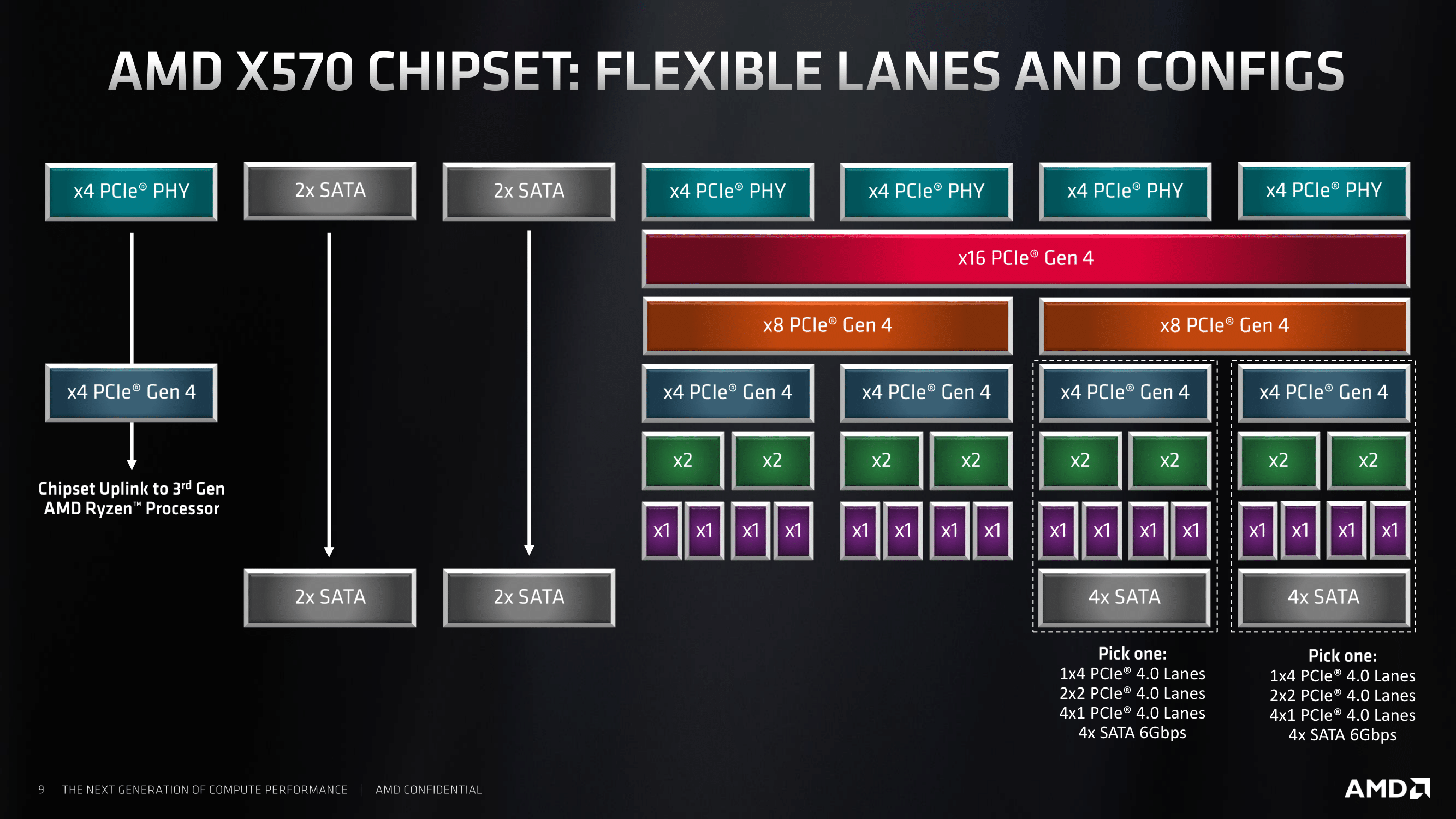AMD Chipset Comparison: B550 Specs vs. X570, B450, X370, & Zen 3 Support (2020)
Posted on
In this content, we’re going to be breaking-down the AMD B550 vs. X570, B450, X470, X370, and A320 chipset specifications number-by-number. Our goal is to look at this purely from a facts-based angle of what the differences are, and those differences will include both numerical specification differences (number and type of lanes afforded) and forward or backwards compatibility differences. This includes the intent of the 500-series chipsets to support Zen 3 architecture (reminder: that’s not the same as Ryzen 4000 mobile, nor is it the same as Ryzen 3000 desktop), while the existing B450 and X470 boards are left to cap-out at Ryzen 3000 series (Zen 2) parts.
We have some additional discussion of the basics of naming, including CPU naming distinctions, in our video component that accompanies this article. You may get more information on the differences between AMD Zen generations and Ryzen generations in that content.
B550 vs. B550A
First off, B550A, which has already been out and which we have covered, is not the same as B550. B550A is made only for OEMs and SIs (system integrators) for pre-built systems. The entire point of B550A was to basically get the number “500” onto the box to make it seem new. B550A is just B450. It’s identical. The only difference is that the name was changed for pre-built PC providers.
That out of the way, B550 is the actually new one that’s interesting. The AMD B550 chipset release date is June 16, with most manufacturer motherboards shipping by July. Outside of chipset choice, the biggest consideration would be VRM quality, PCIe generation usage, and BIOS quality, but that’s a different topic.
Future Support
Outside of the I/O differences that we’ll discuss, the primary advantage for the 500-series chipsets going forward is that AMD is segmenting its support for future CPU architectures. The B550 and X570 chipsets will both support the unreleased Zen 3 architecture when it launches, presumably later this year, while B450 and X470 will only support up to Zen 2 CPUs. In terms of product IDs, that means up to Ryzen 3000 will be supported on the 400-series and 300-series (most of the time), with some caveats, and at least up to Ryzen 4000 will be supported on the 500-series. This additional future-looking support will be the driving reason for upcoming board purchases to consider 500-series boards rather than 400-series, especially considering a lot of the 400 boards are otherwise almost certainly perfectly capable of driving stock or moderately overclocked CPUs of even the next generation. Officially, AMD only marked AM4 for support into 2020, and it seems as if AM4 life has been expanded by at least another 6 months to a year with the 500 series + Zen 3 support. Ryzen 1000 isn’t supported on all X470 and B450 boards due to limitations of space on the BIOS ROM. 3000 APUs are not supported on x570 or B550, but 3000 desktop CPUs go through B550.
AMD B550 Chipset
Here’s a block diagram of AMD’s B550 chipset. Remember that the CPU’s capabilities are independent and unchanged by the chipset outside of BIOS lock-downs, so PCIe Gen4 on the CPU will run directly to the primary PCIe x16 slot and primary M.2 socket. That means B550 motherboards, unlike their predecessors, will officially support PCIe Gen4 for up to two devices. Some early BIOS revisions on B450 motherboards also allowed this, but that was erased with later AGESA updates. The chipset downlink remains PCIe Gen3 x4 because the chipset doesn’t extend any PCIe Gen4 lanes to other devices, so the extra downlink bandwidth found on X570 is unnecessary.
Chipset Differences
Time to talk about the chipset differences. We made a table for this and have verified the information as accurate.
AMD Chipset Specs & Comparison (2020) | GamersNexus.net | |||||||
| Chipset | X570 | B550 | X470 | B450 | X370 | B350 | A320 |
| Officially Supports (some boards may expand support) | Zen 3** (*so far; *no 3000 APU support) | Zen 3** (*so far; *no 3000 APU support) | Zen 2 | Zen 2 | Zen+, (incl. 3000 APUs) sometimes Zen2 | Zen+, (incl. 3000 APUs) sometimes Zen2 | Zen+, (incl. 3000 APUs) sometimes Zen2 |
| Chipset Link | PCIe 4.0 x4 | PCIe 3.0 x4 | PCIe 3.0 x4 | PCIe 3.0 x4 | PCIe 3.0 x4 | PCIe 3.0 x4 | PCIe 3.0 x4 |
| Usable PCIe Gen 4 | 16(8 reconfigurable as groups of 4 for 4x SATA or x4 NVMe) | 0 | 0 | 0 | 0 | 0 | 0 |
| Usable PCIe Gen 3 | 0 | 10(2 reconfigurable as SATA) | 0 | 0 | 0 | 0 | 0 |
| Usable PCIe Gen 2 | 0 | 0 | 8 | 6 | 8 | 6 | 4 |
| SATA III (6Gbps) | 4 | 4 | 4 | 2 | 4 | 2 | 2 |
| SATA Express | 0 | 0 | 2x(or 4x SATA) (or x4 NVMe Gen 3) | 2x(or 4x SATA) (or x4 NVMe Gen 3) | 2x(or 4x SATA) (or x4 NVMe Gen 3) | 2x(or 4x SATA) (or x4 NVMe Gen 3) | 2x(or 4x SATA) (or x4 NVMe Gen 3) |
| USB 10Gbps | 8 | 2 | 2 | 2 | 2 | 2 | 1 |
| USB 5Gbps | 0 | 2 | 6 | 2 | 6 | 2 | 2 |
| USB 480Mbps | 4 | 6 | 6 | 6 | 6 | 6 | 6 |
We’ll start with X570 vs. B550 chipset differences, as that’s likely the biggest question right now. Both chipsets support up to Zen 3 so far. We don’t know if they will support beyond that, but it seems unlikely. X570 uses a Gen4 chipset link, while B550 uses Gen3. That’s because X570 has PCIe Gen4 lanes off of the chipset that are separate from the CPU’s lanes, something B550 has 0 of. These are referred to as “general purpose” lanes and can be reconfigured into almost anything. Intel also has general purpose PCIe lanes on its chipset, but has additional phrasing for HSIO lanes, or high-speed I/O lanes, and makes distinctions between connected devices.
X570’s Gen4 lanes can be split into sub-groups, and we’ll need to briefly cut to an AMD slide for that.
Here’s the AMD X570 lane configuration in more detail than AMD’s original block diagram. We’re interested in those large blocks on the right side. There are four sets of x4 lanes listed here, so that’s the 16 number we just saw in our table, and those can be broken into any of the configurations below them. For example, these could be broken into a single x8 PCIe Gen 4 slot, as illustrated by the orange bar on the left, and then the other 8 could be comprised of a PCIe Gen4 device and 4x SATA ports, or you could do 8x SATA ports, or if you’re making some weird mining board on X570, you could do 8 PCIe x1 slots. You get the idea. It’s pick-and-choose up to 16, more or less, with only a few guidelines.
Back to our table, we’ll pick up on the Gen3 line. B550 has 10 PCIe Gen3, with only 2 reconfigurable to SATA. We should clarify that “reconfigurable” means this is something the motherboard manufacturer can choose to do, not something the user can choose to do.
Neither X570 nor B550 have Gen2 general purpose lanes, but both have 4x SATA III (6Gbps) ports natively supported, 0 SATA Express, and they split USB 10Gbps into 8 on X570 and 2 on B550. USB 5Gbps is 2 on B550, with USB 480Mbps as 4 on X570, 6 on B550. The total USB native support is 12 on X570 and 10 on B550. We listed it with speeds since the USB-IF totally screwed its naming convention, but if you prefer names, that’d be USB 2.0 at 480Mbps, the originally-named USB 3.0 at 4.8Gbps, and then whatever 10 is, because they keep changing the damn names and we can’t keep up anymore. It’s probably USB 3.7 sqrt144 Gen0.5. Modern AMD CPUs also have 4x USB 10Gbps lanes, so you’ll always get at least that as long as the motherboard maker put the ports on the board.
Another reminder here: Limiting the chipset to this assortment of I/O devices doesn’t mean the motherboard is limited to just these. In addition to the devices powered by the lanes located on the CPU’s I/O die, which is the larger of the three chiplets on AMD’s design, the motherboard manufacturers can also buy third-party controllers to add more support. For example, a common choice is to buy an Aquantia NIC for 10Gb LAN. It’s not as common these days, but you sometimes see motherboard makers buying additional USB or SATA controllers to allow for more connected devices, or PEX/PLX chips to bifurcate the PCIe lanes. The chipset isn’t the only source of I/O, but it adds to cost to expand I/O capabilities, so most boards do stick close to the native support of the CPU and chipset combined. Similarly, boards also don’t have to use every single lane on the chipset if they don’t want to -- mini-ITX might be a good example of this, where a lot of them stop at 2 SATA ports.
B450 has been our go-to recommendation lately for anyone who isn’t making use of PCIe Gen4 and who doesn’t need the higher-end VRMs associated with X570. B450 and X470 are still perfectly capable and make sense for people who won’t use Gen4 devices. That said, going forward, the expanded support of X570 and B550 to include Zen 3 will likely change our recommendation toward B550 rather than B450. B450 supports up to Zen 2, uses a Gen3 link, and hosts zero PCIe 4 and PCIe 3 general purpose lanes of its own; instead, it runs 6 PCIe generation 2 general purpose lanes, compared to 8 on the X470 chipset. SATA III availability is 4 ports natively for X470, 2 for B450, with the option to split other lanes off into SATA. Those would come from your Gen2 general purpose lanes or from your SATA Express lanes, of which both last-gen chipsets have 2. Each SATA Express lane can become 2x SATA ports, or you can take both and turn them into a x4 NVMe Gen3 M.2 device.
SATA support on these is equivalent for USB 10Gbps, it’s 6 and 2 for USB 4.8Gbps, and it’s 6 and 6 for USB 2.0, or 480Mbps.
The primary difference between B450 and B550 is the increased PCIe general purpose lanes that also benefit from becoming PCIe Gen3, rather than PCIe Gen2.
Let’s recap first-gen Ryzen’s launch chipsets now: X370, B350, and A320. X300 is covered in our launch coverage, if you’re curious about that implementation.
All three of these stopped officially supporting Ryzen past the Zen+ CPUs. X370, B450, and A320 support includes the confusingly named Ryzen 3000 CPUs that have APUs in them, and often includes Ryzen 3000 desktop CPUs, but not always. That requires a beta BIOS.
PCIe Gen2 general purpose lane assignment is 8 on X370, 6 on B350, and 4 on A320, SATA III runs 4, 2, and 2, respectively, and SATA Express is identical on all 3. This is commonly split into M.2 or SATA devices. The USB 10Gbps support is 2, 2, and 1, from high-end to low-end, 4.8Gbps is 6, 2, and 2, and 480Mbps is 666, woe to you, oh earth and see, let him who hath understanding reckon the number of the beast.
That recaps the chipset differences in a clean fashion. There are a few other items to add:
AMD is trying to position B550 as a cheaper version of X570, rather than as a full step down in classification. The B450 boards technically didn’t support dual-GPU support, but B550 will, for whatever that’s worth. (It’s not much).
Based on AMD’s slide deck to media, the B550 chipset will not support the 3000 APUs, not to be confused with Zen 3 -- we have no idea if its APUs will be supported, assuming it has any. The Athlon 3000G and Ryzen 3200G and 3400G APUs will not officially work in B550.
Editorial, Host: Steve Burke
Video: Keegan Gallick




